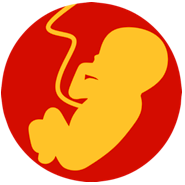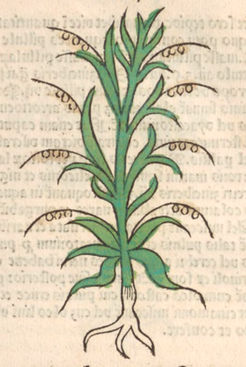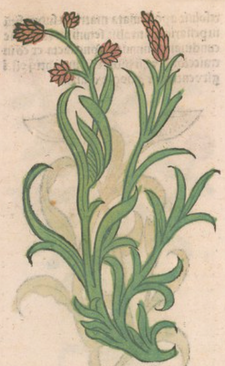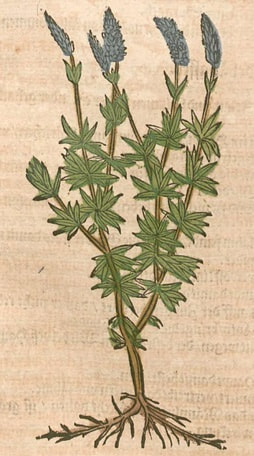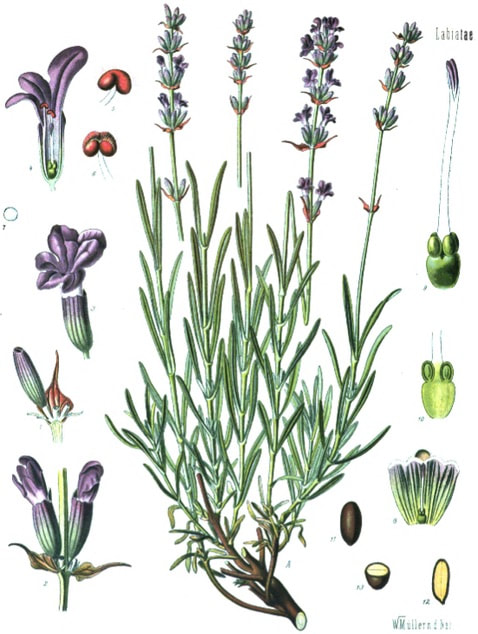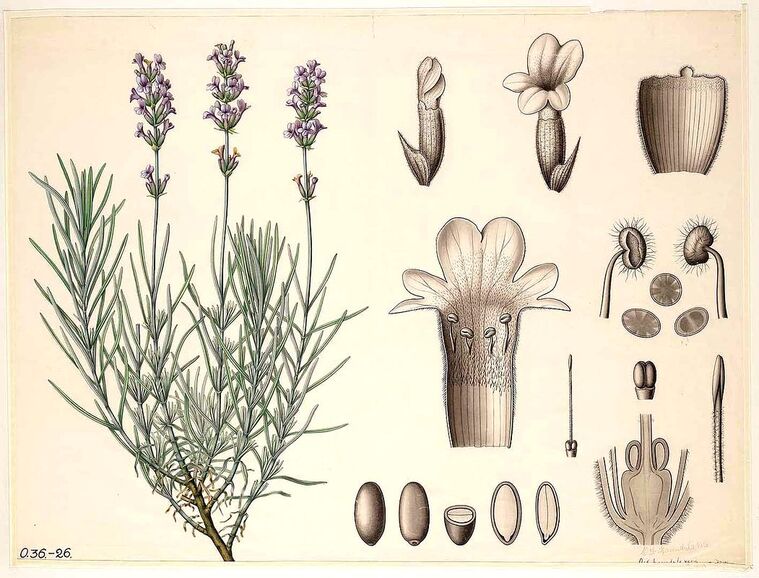Sentry Page Protection
Krauterbuch, Lonitzer, 1578
Koehler's Medizinal Pflanzen, 1887
Lavendula angustifolia
Botanische wandplaten, (1904–1914)
Botanische wandplaten, (1904–1914)
Botanical name:
Lavendula officinalis (syn. L. vera, L. angustifolia, L. spica, L. vulgaris)
Parts used:
Flower
Temperature & Taste:
Warm, dry. Pungent, Bitter
Classifications:
2H. CARMINATIVE
3A. SUDORIFICS & DIAPHORETICS. 3E. DIURETIC. 3G. EMMENAGOGUE. 3M. ARTHRITIC
4e. STOMACHIC. 4j. NERVINE
Lavendula officinalis (syn. L. vera, L. angustifolia, L. spica, L. vulgaris)
Parts used:
Flower
Temperature & Taste:
Warm, dry. Pungent, Bitter
Classifications:
2H. CARMINATIVE
3A. SUDORIFICS & DIAPHORETICS. 3E. DIURETIC. 3G. EMMENAGOGUE. 3M. ARTHRITIC
4e. STOMACHIC. 4j. NERVINE
Uses:
1. Clears Cold and Damp, Opens the Orifices, Stops Wind and Spasms:
-‘Special good use for all griefs and pains of the Head and Brain that proceed of a Cold cause’ (Culpeper)
-‘if it be sodden in water and drunk that water it will heal the Palsy and many other ills’ (Agnus Castus, 14th century)
-Apoplexy, Epilepsy, Paralysis, Vertigo, Dizziness
-Sluggishness, Cramps, Spasms, Convulsions, Fainting, Hysteria.
-'useful in melancholia and epilepsy' (Avicenna)
-Panic Attacks; Drug Withdrawal, Delusions
2. Moves the Qi, Eases Pain:
-promotes Rest and eases pain, used internally and externally;
-Anxiety, Depression, Nervousness, Palpitations, Restlessness
-Abdominal Fullness, Irritable Bowel Disorder;
-muscular and nervous Tension, rheumatic pain.
-Liver Qi constraint, marked by pain, pressure or tenderness of the Liver, irritability and Headache.
-'relieves neuralgia and pain in ribs' (Avicenna)
-Culpeper said ‘it frees the Liver and Spleen from obstructions’,
-wind Colic.
3. Moves the Blood and Qi, Clears Cold, Promotes Menstruation:
-promote Menstruation when obstructed by Cold, Qi Constraint, or Blood Stagnation;
-Cramps, Painful, Scanty, Delayed or Irregular Menstruation, clear or white discharge and PMS.
-difficult and painful Labor (may be used during the last few weeks of pregnancy), for which Lavender seed has also been used
-expel a Dead Child and the Afterbirth.
-promotes Fertility in women.
4. Resists Poison:
-‘it is mingled also profitably with Antidotes’ (Dioscorides)
-bites of Snakes and other venomous creatures, including Mad Dogs.
5. Warms the Kidneys, Promotes Urine:
-Edema
-suppressed or difficult urination from cold.
6. Clears Cold Phlegm, Stops Cough and Wheezing:
-Dioscorides said the ‘Decoction of it as the Hyssop is good for ye griefs in ye Thorax’
-Wheezing, Spasmodic Cough and Asthma from Qi constraint
-Catarrh
7. Externally:
-Toothache, Neuralgia, Sprains, Rheumatism, Nervous Headaches (Spirit, Oil, Baths and Compresses are best).
-the Oil has also been used to kill Lice, and is used to prevent mosquito bites.
-the Oil has been applied to Burns to reduce pain and scarring.
-the Oil of Lavender promotes growth of hair when weak or thinning.
-local Infections, Wounds, and various skin conditions such as Eczema, Psoriasis, Pimples, Rashes and Dermatitis.
-In baths, it is useful for Pain, Neuralgia and especially Paralysis.
-a Hip-bath also promotes Childbirth.
Dose:
Often taken with Wine or Oxymel
Decoction: 2–6 grams;
Powder: 1–3 grams
Essential Oil: 2–5 drops
Often taken with Wine or Oxymel
Decoction: 2–6 grams;
Powder: 1–3 grams
Essential Oil: 2–5 drops
Main Combinations:
Lavender & Rosemary
1. Paralysis, Apoplexy, Falling Sickness, Cramps, Convulsions, Vertigo, Dizziness, Lavender with Sage, Rosemary, Borage, Balm, Feverfew, Orange flower, Peony, Cinnamon, Nutmeg, Sandalwood, Pearl (as in Spirit of Lavender)
2. Paralysis:
i. Lavender with Sage, Cowslip, Cress, Walnut (Salerno)
ii. Lavender with Sage, Hyssop, Mint, Clove, Calamus, Juniper berry, Peony (as in Powder for Paralysis and Vertigo of Nicholas)
3. Apoplexy, Lavender with Doronicum, Peony, Costus, Rosemary, Siler, Peony, Nutmeg, Clove, Aloeswood, Amber (as in Powder Against Apoplexy)
4. Epilepsy, Vertigo, Lavender with Horehound, Fennel, Asparagus root, Cinnamon (Culpeper)
5. Childhood Epilepsy, Lavender with Peony, Nutmeg, Amber
6. Nervine:
i. Lavender with Mint, Valerian, Camomile
ii. Lavender with Rosemary, Balm, Primula flower (Becker)
7. Dizziness, Vertigo:
i. Lavender with Horehound, Fennel, Asparagus root, Cinnamon
ii. Lavender with Stoechas, Eyebright, Thyme, Betony, Rosemary, Aniseed, Peony root, Clove, Aloeswood (as in Tincture for Vertigo)
8. Catarrh from Wind-Damp, Lavender with Myrobalans Chebulic, Belleric, and Emblic, Cinnamon, Clove, Galangal, Nutmeg, Rosemary (as in Wine for Catarrh of Pope Adrian)
9. Insomnia, Lavender with Valerian, Hops, Betony, St. Johns wort (Rose)
10. To purge the Head, Lavender, Rosemary, Basil seed, Nigella, Pyrethrum, Ginger, decoct (Herbarius latinus, Petri, 1485)
11. Palpitations, Dizziness, Vertigo, Lavender with Cinnamon, Nutmeg, Clove
12. Difficult Labor:
i. Lavender seed, Plantain seed, Endive seed, Pepper (Memorial Pharmaceutique, 1824)
ii. Lavender with Savin, Marjoram, Squinanth, Indian Spikenard
iii. Lavender with Amber and Cinnamon
13. A bath to keep beautiful, Lavender with Bay leaf, Barley, Oatmeal, Bran, Rice, sodium bicarbonate
Major Formulas:
Decoction for Vertigo (Culpeper)
Decoction for Difficult Childbirth (Barbette)
Four Thieves Vinegar
Powder of Lavender (Gerard)
Powder for Paralysis and Vertigo (Nicholas)
Powder for Vertigo
Powder of Lavender Seed to Promote Labor
Powder Against Apoplexy (2) (Zwelfer)
Ointment for Congealed Blood
1. Aromatic Powder:
Primarily used in washes and fomentations:
i. Marjoram, Peppermint, Rosemary, Wild Thyme, Lavender (2 parts each), Clove, Cubeb (1 part each). Make a coarse powder. (Pharmacopoeia Sardoa, 1773)
ii. Lavender, Camomile, Peppermint, Balm, Thyme, Marjoram (equal parts). (Armen Pharmacopoea, Hufeland, 1825)
iii. Lavender, Balm, Peppermint, Sage, Thyme, Wormwood, Water Mint, Oregano, Rosemary. This was also prepared into a tincture (1 part powder with 9 parts Alcohol 22%) to be used externally. (Formulaire Pharmaceutitique a l’usage des Hospitaux Militaires de France, 1821)
iv. Rosemary, Rue, Sage, Hyssop, Lavender, Wormwood, Oregano, Thyme, Bay leaf, Rose, Camomile, Meliot, Elder, Ammonium chloride (equal parts). Used as a fomentation. (Pharmacopoeia Generalis, 1783)
2. Cephalic Powder:
i. Marjoram, Mint, Balm, Thyme, Lavender, Arnica (equal parts). Used as a fomentation. (Pharmacopoeia Herbipolitania, 1796)
ii. Betony, Hyssop, Lavender, Marjoram, Oregano, Rosemary, Rue, Sage, Wild Thyme, Camomile, Meliot, Rose, Elder flower, Bay leaf (1 oz. each), Ammonium chloride (half oz.). (Dispensatorium medico pharmaceuticum Palatinatus, 1764)
3. Compound Vinegar of Lavender:
i. Cinnamon, Clove, Nutmeg (1 dram each), Peppermint (half oz.), Lavender, Rosemary (1 oz. each), Vinegar (8 oz.), Proof Spirit (20 oz.). Distil 28 parts. (Pharmacopee Usuelle, Louvain, 1821)
ii. Fresh herbs of Wormwood, Mentha crispa, Rosemary, Rue (1 1/2 oz. each), dried flowers of Lavender (2 oz.), Calamus, Cinnamon, Nutmeg, Clove (2 drams each), Vinegar (10 lbs.). Macerate 10 days, express and filter. (Brugnatelli)
4. Compound Spirit of Lavender:
i. Spirit of Lavender (3 pints), Spirit of Rosemary (1 pint), Cinnamon, Nutmeg both bruised (half oz. each), Red Sandalwood (1 oz.). Macerate 14 days, strain. (London)
ii. some versions replaced Spirit of Rosemary in the preceding with Spirit of Sage.
Cautions:
1. Not used during pregnancy.
Main Preparations used:
Conserve of the Flowers, Distilled Water, Distilled Oil
1. Water of Lavender:
i. Lavender (1 part), Water (4 parts). Distil one-half (Pharmacopoeia Gallica, 1818)
2. Spirit of Lavender:
i. Fresh Lavender flowers (2 lbs.), Rectified Spirit (1 gallon) Water (sufficient to prevent empyreuma). Macerate 24 hours, then distil one gallon with gentle heat. (London). The Dublin Pharmacopoea only required 5 pints to be distilled off.
ii. Fresh Lavender flowers (2 lbs.), Alcohol (8 pounds). Distil off 7 pounds in the heat of a water-bath. (Edinborough)
1. Not used during pregnancy.
Main Preparations used:
Conserve of the Flowers, Distilled Water, Distilled Oil
1. Water of Lavender:
i. Lavender (1 part), Water (4 parts). Distil one-half (Pharmacopoeia Gallica, 1818)
2. Spirit of Lavender:
i. Fresh Lavender flowers (2 lbs.), Rectified Spirit (1 gallon) Water (sufficient to prevent empyreuma). Macerate 24 hours, then distil one gallon with gentle heat. (London). The Dublin Pharmacopoea only required 5 pints to be distilled off.
ii. Fresh Lavender flowers (2 lbs.), Alcohol (8 pounds). Distil off 7 pounds in the heat of a water-bath. (Edinborough)
Click the Tabs above for more information on this Medicine

